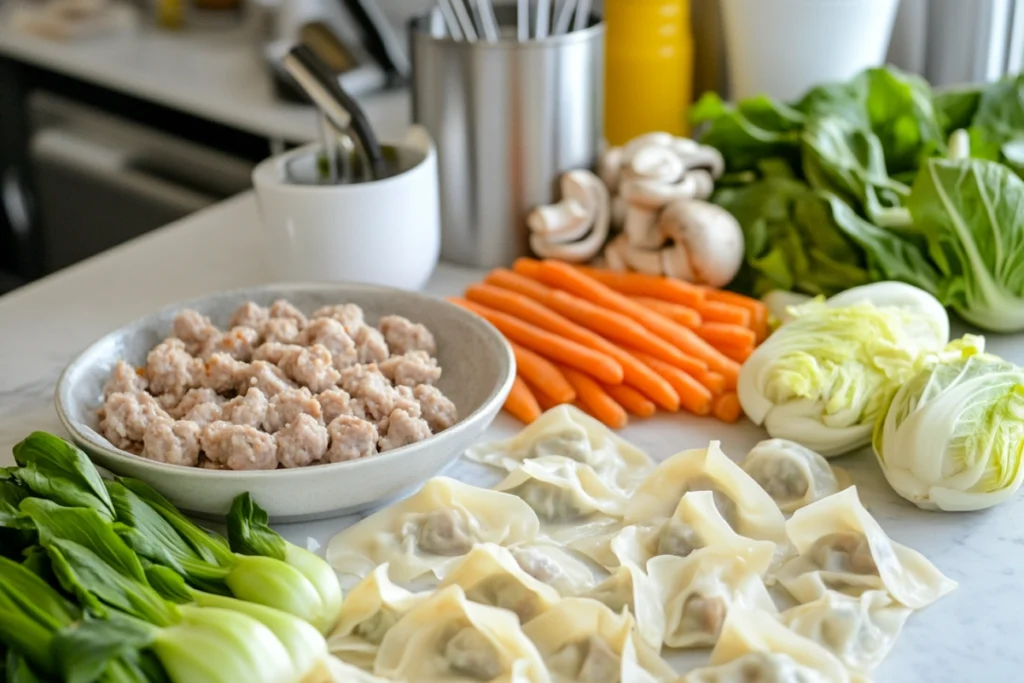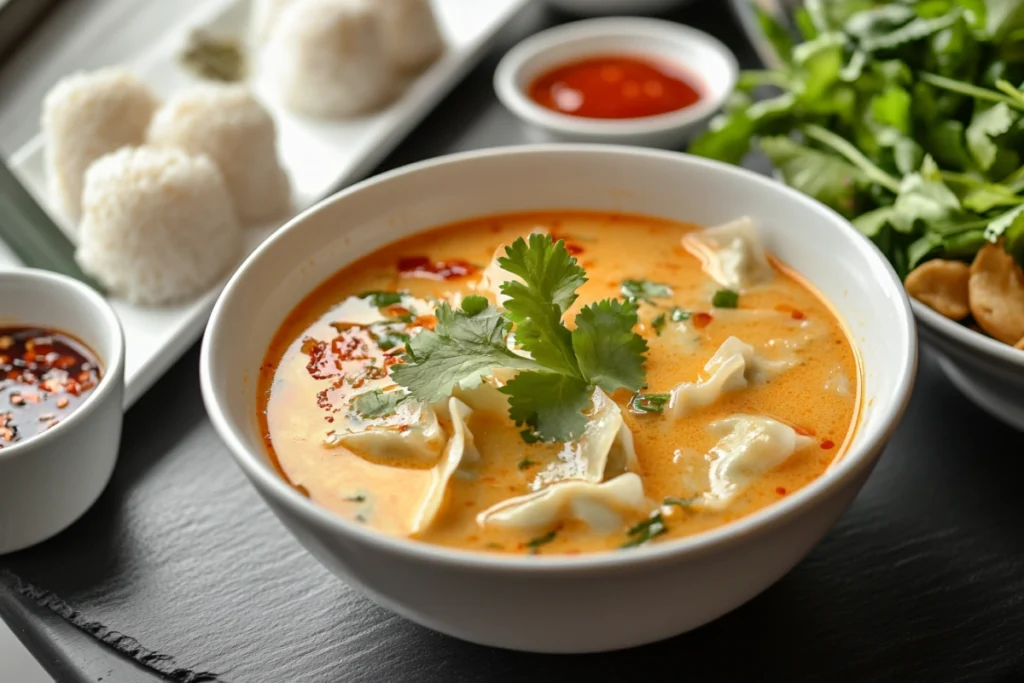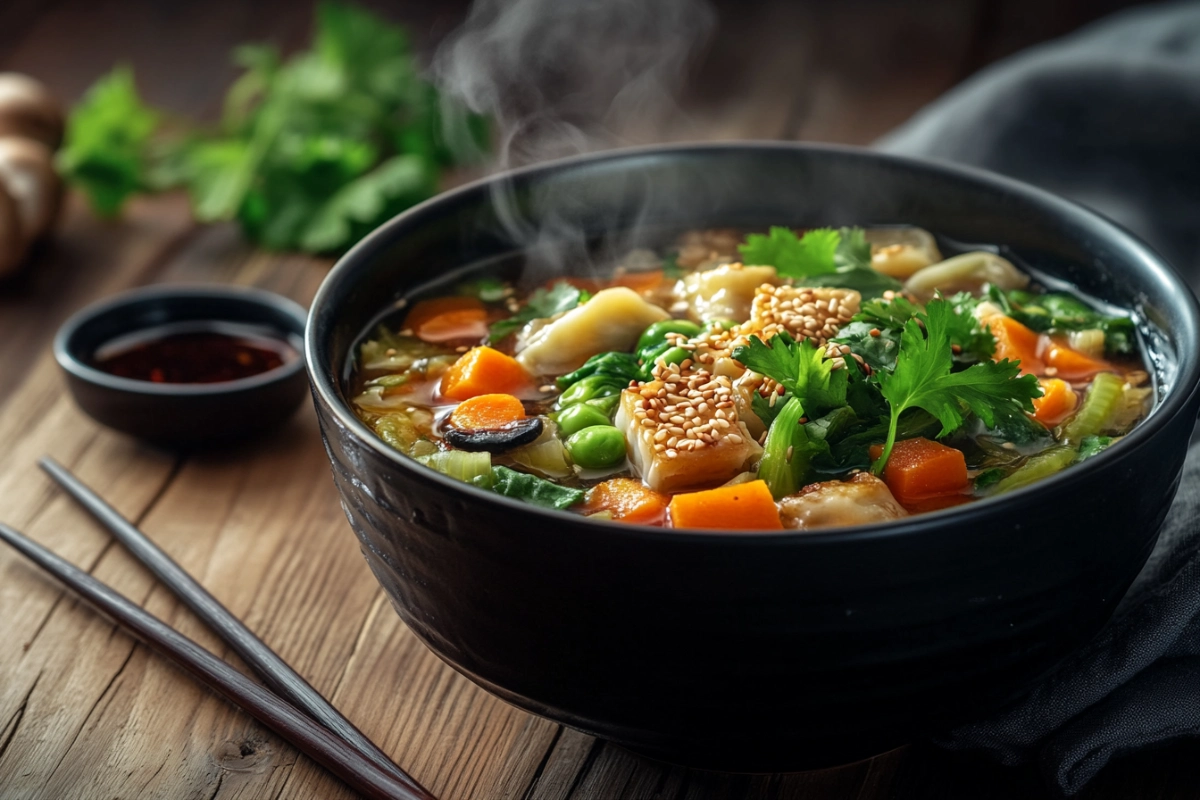Subgum Wonton Soup is a culinary gem that combines tender wontons with a vibrant medley of vegetables and savory broth. This iconic dish, deeply rooted in Chinese cuisine, has gained popularity worldwide for its rich flavors and comforting appeal. In this article, we’ll uncover its history, break down its key ingredients, explore preparation methods, and examine its health benefits. Whether you’re a seasoned chef or a soup enthusiast, this comprehensive guide will inspire you to enjoy or create your perfect bowl of Vegetable wonton Soup.
What is Subgum Wonton Soup?
Subgum Wonton Soup is more than just a simple bowl of soup with dumplings. It’s a delightful mix of flavors and textures. This dish blends traditional Chinese cooking with a modern twist, making it both versatile and unique. But what makes it stand out? Let’s explore.
Origins and Meaning of Subgum
The word subgum (雜錦 in Chinese) means “assorted” or “mixed.” It highlights the colorful mix of vegetables and proteins that go along with the wontons. This cooking style comes from Cantonese cuisine, where chefs focused on creating balanced and visually appealing dishes. Over time, Subgum Wonton Soup option became popular in Chinese-American restaurants, bringing together traditional Chinese flavors with Western influences.
The Role of Wontons in Chinese Cuisine
Wontons are soft dumplings filled with seasoned meat or vegetables. They are a key part of many Chinese soups and are often associated with good luck and happiness, especially during Lunar New Year. In Vegetable wonton soup, these tender dumplings float in a tasty broth, paired with crunchy, fresh vegetables like carrots, bok choy, and mushrooms for added flavor and texture.
Key Ingredients in Subgum Wonton Soup
A perfect bowl of subgum wonton soup begins with fresh, high-quality ingredients. This dish thrives on the harmony of textures and flavors contributed by its diverse components.
Traditional Ingredients and Their Importance
The key to any great wonton soup lies in the broth, often made by simmering chicken bones, ginger, and scallions to achieve a rich and fragrant base. Subgum wonton soup enhances this with a vibrant mix of vegetables, such as bok choy, snow peas, carrots, and mushrooms. These vegetables not only add color but also provide a delightful crunch.
The wontons themselves are another cornerstone of the dish. These delicate dumplings are typically stuffed with a mix of ground beef or shrimp, flavored with soy sauce, sesame oil, and a hint of ginger. Their soft texture contrasts beautifully with the crisp vegetables.
Modern Variations of Subgum Wonton Soup
Modern takes on Vegetable wonton soup often cater to dietary preferences and regional tastes. Some chefs incorporate tofu or shredded chicken to appeal to a broader audience, while others use gluten-free wonton wrappers to accommodate dietary restrictions. You may also find a spicy version of this soup, featuring a splash of chili oil for a bold, fiery kick.
No matter the variation, the balance of flavors and textures remains the essence of subgum wonton soup.
How to Prepare Subgum Wonton Soup

Creating This flavorful soup at home may seem intimidating, but it’s easier than you think. By following a step-by-step process, you can bring this comforting dish to your table with confidence.Here’s the revised version with enhanced use of transitional words to improve flow and readability:
Step-by-Step Recipe Guide
Prepare the Broth: To begin, simmer chicken or vegetable stock with slices of ginger, garlic, and scallions. As the broth cooks, the flavors will meld together, creating a fragrant base for your soup. Allow it to simmer for at least 20 minutes for the best results.
Make the Wontons: Meanwhile, combine ground beef (or shrimp), minced garlic, soy sauce, sesame oil, and chopped green onions in a bowl. Then, wrap small portions of the mixture in wonton wrappers, carefully sealing the edges with water to prevent them from opening during cooking.
Cook the Vegetables: Next, slice bok choy, carrots, and mushrooms into bite-sized pieces. To maintain their crunch, lightly blanch them in boiling water before adding them to the soup.
Assemble the Soup: Once the broth is ready, gently drop the prepared wontons into the simmering liquid. Cook them until they float, which indicates they are done. After that, add the blanched vegetables and let them warm through for a few minutes.
Season to Taste: Finally, adjust the flavor by adding soy sauce, white pepper, and a dash of sesame oil. Taste the soup to ensure the seasoning is just right before serving.
Common Mistakes to Avoid
Overcooking the Wontons: Be careful not to overcook the wontons, as these delicate dumplings can become mushy if left in the broth too long. For best results, remove them as soon as they float to the surface.
Skipping the Pre-Blanching Step: Another common mistake is skipping the pre-blanching step for vegetables. Without blanching, the vegetables may lose their vibrant color and firm texture when cooked directly in the soup. Blanching ensures they stay crisp and visually appealing.
With these tips and steps, you can confidently master the art of making subgum wonton soup at home. By paying attention to small details, you’ll create a dish that is not only delicious but also visually stunning.
Nutritional Benefits of Subgum Wonton Soup
Subgum wonton soup is not only a feast for the senses but also a nutritious addition to your diet. Packed with proteins, vitamins, and minerals, this dish offers a wholesome way to enjoy a satisfying meal.
Nutritional Value of Ingredients
The wontons, filled with lean protein like ground beef, shrimp, or tofu, provide essential amino acids necessary for muscle repair and growth. Meanwhile, the vibrant array of vegetables—bok choy, mushrooms, carrots, and snow peas—contribute a wealth of vitamins A and C, along with antioxidants that boost immunity.
The broth, often simmered with ginger and garlic, adds a therapeutic touch. Ginger aids digestion, while garlic has anti-inflammatory properties, making this soup a comforting remedy for cold days or when you’re feeling under the weather.
Nutritional Content (Per 100g)
Below is a breakdown of the estimated nutritional values for subgum wonton soup per 100g serving.
| Nutrient | Amount | Daily Value (%) |
|---|---|---|
| Calories | 65 kcal | 3% |
| Protein | 4 g | 8% |
| Carbohydrates | 8 g | 3% |
| Dietary Fiber | 1.2 g | 4% |
| Fat | 1.5 g | 2% |
| Sodium | 450 mg | 19% |
| Vitamin A | 400 IU | 8% |
| Vitamin C | 10 mg | 11% |
| Calcium | 20 mg | 2% |
| Iron | 0.7 mg | 4% |
Health Benefits of Including Wonton Soup in Your Diet
Enjoying subgum wonton soup regularly can contribute to a balanced diet. Its high water content keeps you hydrated, while the nutrient-dense ingredients support energy levels and overall well-being. For those seeking lighter options, the soup can be tailored with low-sodium broth or gluten-free wonton wrappers to meet specific dietary needs.
For more delicious, health-conscious recipes, check out our other recipe articles.
Subgum Wonton Soup Around the World
From bustling streets in China to cozy restaurants in the West, subgum wonton soup has traveled far, adapting to local tastes along the way.
Regional Variations in Asia
In its homeland of China, subgum wonton soup often features authentic ingredients like water chestnuts, bamboo shoots, and Chinese cabbage, reflecting the flavors of traditional Cantonese cuisine. Each region may tweak the recipe slightly, such as adding pickled vegetables or local spices to make it unique.
How Western Cultures Have Adapted the Dish
When this soup made its way to Western countries, chefs embraced innovation. Many versions include Western-style ingredients, such as celery, zucchini, or even kale. You might also find spicy subgum wonton soup versions, featuring chili oil or hot sauce for a bold kick that caters to spice-loving palates.
Regardless of the variations, the heart of the dish remains the same: the delicate wontons, the harmonious broth, and the vibrant vegetables. Its global appeal lies in its adaptability and timeless comfort.
Popular Questions About Subgum Wonton Soup
With its unique name and delightful flavors, subgum wonton soup often sparks curiosity. Here, we’ll address some common questions about this beloved dish.
What Makes Subgum Wonton Soup Unique?
The standout feature of Vegetable wonton soup is its vibrant medley of vegetables, which sets it apart from traditional wonton soups. While standard wonton soups often focus on the dumplings and broth, subgum brings a balance of textures and flavors with crisp vegetables like bok choy, carrots, and mushrooms. This combination creates a hearty, satisfying meal that feels both nourishing and indulgent.
Is Subgum Wonton Soup Gluten-Free?
Traditional subgum wonton soup may not be gluten-free due to the wheat-based wonton wrappers and soy sauce. However, it’s easy to adapt the recipe for a gluten-free diet. By using gluten-free wrappers and tamari instead of regular soy sauce, you can enjoy all the deliciousness without compromising dietary needs.
FAQs About Subgum Wonton Soup
Got questions about subgum wonton soup? Here are clear answers to some common ones.
Can Subgum Wonton Soup Be Made Vegetarian?
Yes, it can! While the traditional recipe uses beef b or shrimp in the wontons, a vegetarian version works just as well. You can fill the wontons with tofu, chopped mushrooms, or mashed sweet potatoes with seasoning. The broth can be made with vegetable stock, and the mix of fresh vegetables stays the same, making it just as tasty.
How Does Subgum Wonton Soup Compare to Other Wonton Soups?
Subgum wonton soup is different because it includes a lot of vegetables. While classic wonton soups focus mostly on the wontons and broth, subgum adds crunch and variety, making it a more filling and complete dish. Its bright colors and mix of textures make it a favorite for those who want a light yet satisfying meal.
What Vegetables Are Usually in Vegetable wonton soup?
The vegetables can vary, but popular choices are bok choy, mushrooms, carrots, snow peas, and water chestnuts. This mix gives a great balance of crunch, flavor, and nutrition.
Is Subgum Wonton Soup Spicy?
No, it’s not usually spicy. But if you like heat, you can easily spice it up by adding chili oil, sliced jalapeños, or a bit of hot sauce. This makes it a flexible dish for different tastes.
Serving Suggestions for Vegetable wonton soup

Vegetable wonton soup is a versatile dish that works beautifully as either a light starter or a satisfying main course. In fact, the way you serve it can greatly elevate the dining experience, making it even more memorable for your guests.
Perfect Pairings with Subgum Wonton Soup
To create a complete meal, you can pair subgum wonton soup with steamed rice or a side of stir-fried noodles. The rice, for instance, helps to absorb the flavorful broth, while the noodles add a satisfying heartiness. Additionally, a plate of crispy spring rolls or dumplings makes an excellent accompaniment, complementing the soup’s soft wontons and crunchy vegetables.
For those looking for a lighter option, try serving the soup alongside a simple Asian-inspired salad. Ingredients such as shredded cabbage, sesame seeds, and a tangy ginger-soy dressing not only add freshness but also mirror the soup’s zesty flavors perfectly.
Presentation Tips
When it comes to presentation, it truly matters! Serving subgum wonton soup in deep, wide bowls allows you to showcase the colorful vegetables and plump wontons. For added visual appeal and aroma, garnish each bowl with fresh cilantro, chopped green onions, or a drizzle of sesame oil.
If you’re hosting a gathering, consider setting up a “build-your-own soup” station. This way, guests can customize their bowls with toppings like chili flakes, soy sauce, or crispy wonton strips. Not only does this interactive approach add fun to the meal, but it also lets everyone tailor their bowl to their own taste.
Exploring Variations of Subgum Wonton Soup
The classic recipe for Vegetable wonton soup is already delicious, but trying out new versions can bring exciting flavors to your table.
Fusion-Inspired Twists
For a creative spin, you can add coconut milk and a squeeze of lime juice for a Thai-style flavor. Or, mix in a little miso paste to give the soup a Japanese umami taste. These small changes go well with the soup’s original ingredients while making it feel fresh and new.
You could also try using other proteins like shredded chicken, sliced beef, or crispy tofu. These options make the soup more filling and can match a variety of tastes.
Seasonal Adaptations
Using seasonal ingredients is a great way to make subgum wonton soup even more enjoyable. In the winter, you can add hearty vegetables like parsnips or sweet potatoes for a warm and comforting bowl. In the summer, lighter choices like zucchini or snap peas help keep the soup fresh and bright.
No matter how you adapt it, the key elements of subgum wonton soup—its rich broth, soft wontons, and colorful vegetables—always make it a satisfying and comforting dish.
Conclusion
Subgum wonton soup is more than just a comforting dish—it’s a celebration of rich flavors, vibrant colors, and diverse textures. From its origins in Cantonese cuisine to its adaptations around the world, this soup has proven to be both timeless and versatile. Whether you’re enjoying it as a hearty meal or experimenting with seasonal variations, it’s clear that flavorful soup has something for everyone.
By following the steps and tips outlined in this guide, you can recreate this beloved dish in your own kitchen. Remember to embrace creativity, as small tweaks can make it uniquely yours. So why wait? Gather your ingredients and enjoy a warm, flavorful bowl of subgum wonton soup today.

